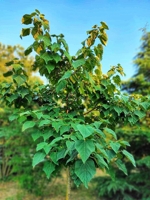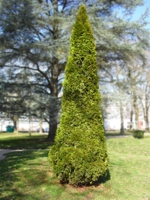Mon-Fri 9am - 5pm Mountain time
Empress Tree vs Emerald Cedar
Paulownia tomentosa
Thuja occidentalis Smaragd
NOT AVAILABLE THIS SEASON - MIGHT RETURN
The Empress Tree is a fast growing, ornamental shade tree. It has purple, fragrant flowers that are quite attractive. The flowers emerge before the leaves in early spring. The leaves of this tree can grow very large, up to 30 cm long.
As one of the fastest growing trees in the world, this tree has been given considerable attention for carbon sequestration projects. It drops many seeds which can make it invasive in warmer climates. Please do some research and plant the right tree in the right place.
The Empress tree’s genus name comes from Princess Paulowna, daughter of Tsar Paul I of Russia.
Emerald Cedar makes a great addition to landscapes, and is often used to form tight hedges or privacy screens. The thick scale-like foliage adds texture and colour to yards and is commonly used to line driveways. Unlike other cedars it retains its green colour throughout the fall and winter.
It is a semi dwarf species, which generally needs little pruning, but if desired it responds well to trimming. Its attractive, columnar shape and dense foliage makes it a desired landscape feature.
The Emerald Cedar won the award of merit from the Royal Horticultural Society.

